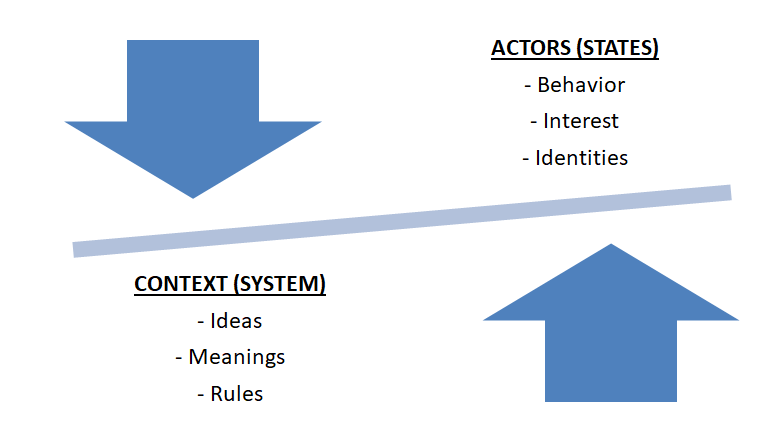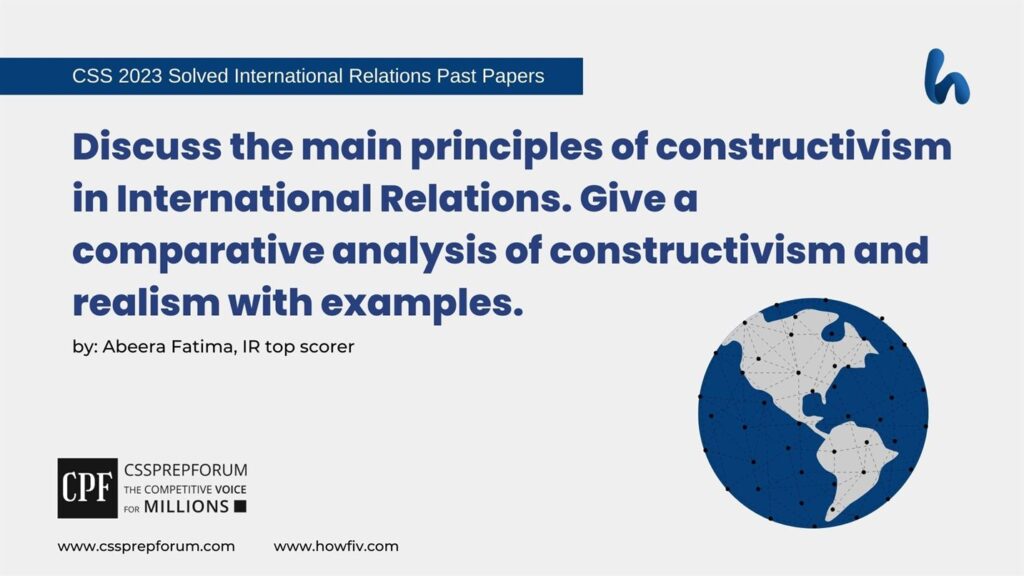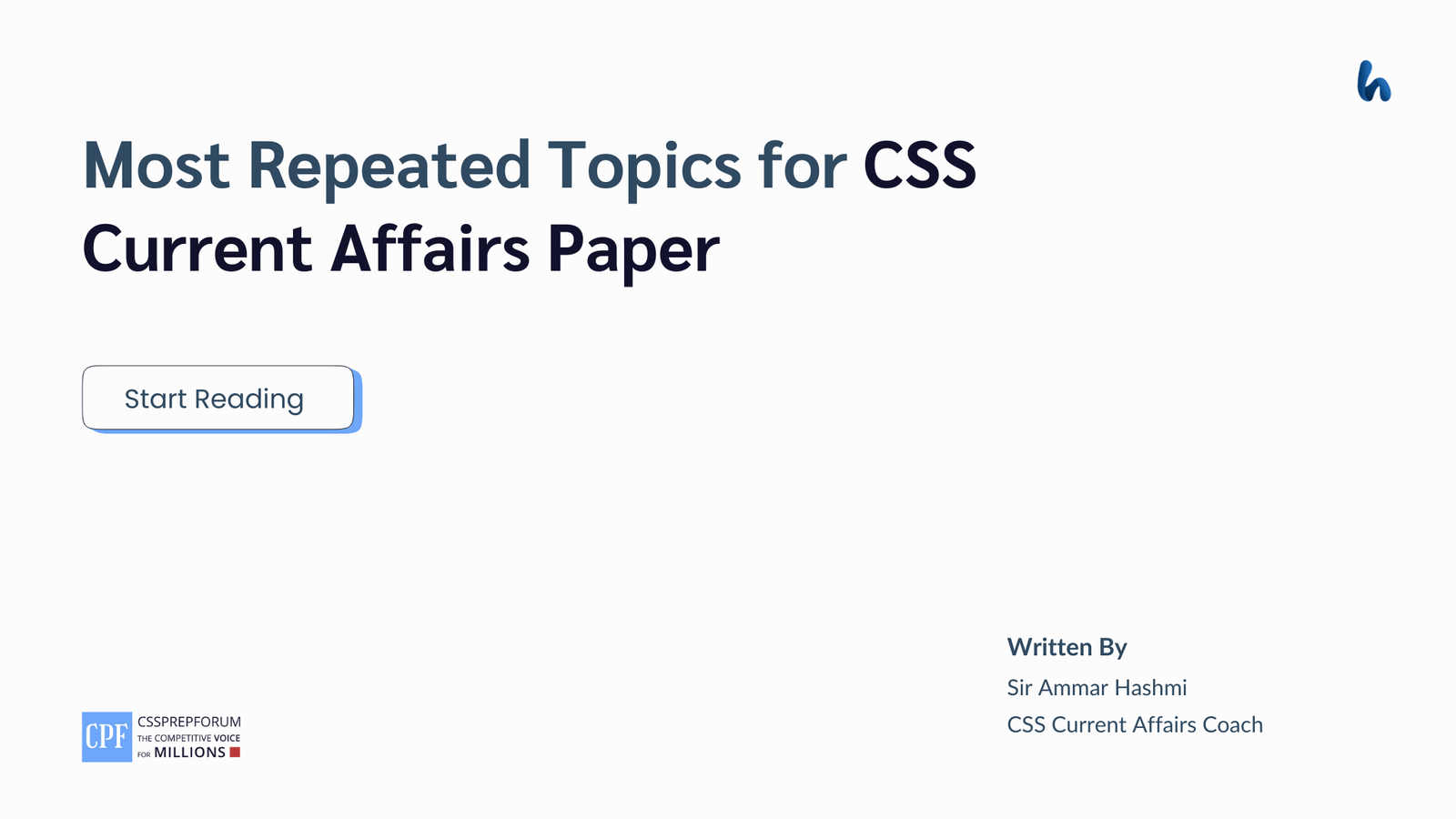CSS Solved International Relations Past Papers | Discuss the main principles of constructivism in International Relations. Give a comparative analysis of constructivism and realism with examples.
The following question is attempted by Miss Abeera Fatima, the top scorer in CSS IR paper. Moreover, the answer is written on the same pattern, taught by Sir to his students, scoring the highest marks in compulsory subjects for years. This solved past paper question is uploaded to help aspirants understand how to crack a topic or question, how to write relevantly, what coherence is, and how to include and connect ideas, opinions, and suggestions to score the maximum.

Question Breakdown
In this question, the examiner has asked you to explain the concept of constructivism in international relations. So, explain the theory and then explain the main principles. Similarly, a comparative analysis is demanded, by the examiner, between constructivism and realism. Explain the comparison with the help of an example. Lastly, note that, in Paper 1 of International Relations, you need to avoid pictorial representations; however, you can use theories, evidence, and assumptions.
Key Words
Constructivism, Realism, International Relations, principles of constructivism, comparative analysis of constructivism and realism, CSS Solved International Relations Past Papers, CSS Solved International Relations Past Papers by Miss Abeera Fatima, Solved International Relations Past Papers, IR by Miss Abeera Fatima, Miss Abeera Fatima the top scorer, International Relations Paper 1 solutions, International Relations Paper 2 solutions, Learn CSS International Relations with Miss Abeera Fatima, Cssprepforum, Howfiv, CSS Solved Papers, CSS Solved Past Papers,
Synopsis
1- Introduction
2- Constructivism in International Relations
3- An overview of the main principles of constructivism in International Relations
4- A glimpse of the comparative analysis of constructivism and realism in International Relations
5- Epilogue
Answer to the question
Introduction
Over time, the discipline of International Relations went through enormous changes in the theoretical perspective to elaborate the state’s behavior in the International saga. However, constructivism is one of the theories to encapsulate the idea of norms, values, and culture in shaping the state’s behavior. Tangible and intangible characteristics of constructivism highlight the possible elements in the International arena. Therefore, the main principles of constructivism are quoted in the account: the essence of the approach in the International System, the constitution of mutual actors and system, mobility of identities and interests of actors, rationality is relative, and knowledge is power. However, a comparative analysis of constructivism and realism delves into the diversification of the approaches in the International saga.
“We live in a world of our making”
-Nicholas Onuf
Constructivism in International Relations
- Define
The behavior of humans is determined by their identity, which itself is shaped by society’s values, history, practices, and institutions. Constructivists hold that all institutions, including the state, are socially constructed, in the sense that they reflect an “intersubjective consensus” of shared beliefs about political practice, acceptable social behavior, and values. Constructivism solely focused on the role of norms, identity, and culture in world politics.

The tangible characteristics of constructivism are size, population, economy, geographic position, and interest. However, the intangible characteristics of constructivism are historical experiences, perception of the world, political culture, national character, and norms.
- Scholar’s viewpoint
Nicholas Onuf first coined the term constructivism to describe theories that stress the socially constructed character of International Relations. In addition, state identity theory is under the shadow of constructivism explained by Alexander Wendt and Peter Katzenstein.
- Rise of Constructivism in International Relations
The end of the cold war, the collapse of the Soviet Union and the fall of the Berlin Wall in 1989, becomes the arrival of a constructive approach to International Relations owing to the failure of traditional theories such as realism and liberalism. The reason for the failure was the unequal distribution of power among states. The space for the agency of individuals is filled by the socially constructed theory. Claiming the end of the cold war is to the efforts made by people, not by states or organizations. Actors, usually powerful ones, like leaders and influential citizens, are continuously shaping and sometimes reshaping the very nature of international relations through their actions and interactions.
An overview of the main principles of constructivism in International Relations
- ✓ Essence of approach in International System
It is, entirely, a social theory that signifies aspects of international relations, shaped by ideational factors. The most important ideational factors are those that are collectively held; these collectively held beliefs construct the interests and identities of actors.
- ✓ Constitution of mutual actors and system
Socially constructed theory, known as Constructivism, refers to the nature of reality and the nature of knowledge which is also called ontology and epistemology in research language. For instance, Alexander Wendt illustrates the social construction of reality by explaining that 500 British nuclear weapons are less threatening to the United States than five North Korean nuclear weapons. In addition, the spread of liberal democracy is socially constructed via mutual recognition between liberal subjects.
- ✓ Mobility of identities and interests of actors
Multiple identities can be socially constructed through interaction with other actors. It is an identity that represents actors who they are, which in turn signals their interests. The identification of a small state, for instance, implies a set of interests that are different from those implied by the identity of a large state. The small state is arguably more focused on its survival, whereas the large state is concerned with dominating global political, economic, and military affairs. States align with their identities; thus, cannot act contrarily to their identities. Germany, despite being a great power with a leading global economy, did not become a military power in the last 20th century. Following the atrocities of Adolf Hitler’s Nazi regime during the Second World War, German political identity shifted from one of militarism to pacifism due to unique historical circumstances.
- ✓ Rationality is relative
Social norms are also a central theme of constructivism. It, generally, defines the standard of appropriate behavior for actors with a given identity. Thus, states comply with the norms that are associated with that identity. The process is also known as ‘the logic of appropriateness’, where actors behave in certain ways because they believe that this behavior is appropriate. Norms are categorized into three types: regulative norms, constitutive norms, and prescriptive norms. Regulative norms order and constrain behavior; constitutive norms create new actors, interests, or categories of action; and prescriptive norms prescribe certain norms, meaning there are no bad norms from the perspective of those who promote them. For example, constructivists would argue that the bulk of states have come together to develop climate change mitigation policies because it is the right thing to do for the survival of humanity. This has, over decades of diplomacy and advocacy, become an appropriate behavior that the bulk of citizens expect their leaders to adhere to.
- ✓ Knowledge is power
Knowledge is built upon other knowledge. The fixing of meanings and the construction of identities allocate different rewards and capacities. It also entails that reality is always under construction, which opens the prospect for change. In other words, meanings are not fixed but can change over time depending on the ideas and beliefs that actors hold.
A glimpse of the comparative analysis of constructivism and realism in International Relations
| FEATURE | CONSTRUCTIVISM | REALISM |
| NATURE OF THEORY | It refers to ideas, norms, values, and culture besides material matter. For instance, constructivist advocates the spread of liberal democracy as civil liberties under the rule of law with an emphasis on individual autonomy, limited government, economic freedom, political freedom, and freedom of speech. | It emphasizes the state’s role, in the national interest and power in world politics. For instance, realist advocates the spread of liberal democracy to emphasize the separation of powers, an independent judiciary, and a system of checks and balances between branches of government. |
| ANARCHY IN THE WORLD SYSTEM | Alexander Wendt describes anarchy as an empty vessel without intrinsic meaning. It is neither conflictual nor cooperative. In the American film “Wag the Tail”, Weber tries to justify the position of the constructivists that anarchy is a proposition made by states. For instance, the intervention of the US in Iraq in 2003, according to constructivists, was influenced by norms and identities to protect human rights and strengthen democracy. | Realist thinkers encapsulate the international system as anarchic and driven by national interest and power. However, norms, values, and ideas are secondary material. Realists, such as Kenneth Waltz, link this lack of a ‘world government’ to the continued occurrence of violence among states. For instance, the intervention of the US in Iraq in 2003 fell into the column of national interest and power. |
| NATIONAL INTEREST | National interest, for the constructivist, is continuously fluctuating according to norms, ideas, culture, and new identities, as norms are socially constructed and evolve with changes in social interaction. For instance, the rise of China is shaped by norms, values, and ideas of the International system; in addition, a classical shift is observed from the uni-polar to a multipolar world. | National interest is constant and a framework for the state; however, it is tied to military, political, and economic power. It is the essence of power politics, according to Hans J Morgentou. For instance, the realistic stance of China’s rise is in favor of growing economic power and military capabilities following national interest. |
| BALANCING | Kenneth Waltz offered a theory of international behavior that suggested states will either seek to balance the power of a stronger actor or bandwagon with that actor. For instance, Following the end of the Cold War, states did not immediately rush to balance the hegemonic power of the United States as the balance of power theory would suggest. | The balance of power theory offers fundamental propositions about the international system. It gives us an understanding of the nature of man, the state, and the international system, why war occurs, and how it could be avoided. Realists believe that the security dilemma can be limited by a balance of power. Kenneth Waltz, for example, contends that wherever two or more major powers exist, a balance of power will prevail by de-facto. |
| CORE ELEMENT | Constructivism loves idealism and holism. | Realism deeply falls in love with institutionalism, individualism, and Statism. |
| METHODOLOGY | Modest and post-positivist methodological frameworks are chalked by constructivists. For instance, works like Kathryn Sikkink’s, The Justice Cascade: How Human Rights Prosecutions Are Changing World Politics embody this normative constructivist spirit | Empirical and positivist methodological frameworks are chalked by realists. For instance, John Mearsheimer’s “The Tragedy of Great Power Politics” is situated within a positivist-realist methodology. |
| CONVERSELY ARGUMENTS | Constructivist argues that power is not just material, but also ideational. | Realists argue that ideas and norms define interest that exists prior to interaction with each other. They further argue that relations do not shape interest. |
Epilogue
Constructivism is often said that actions, interactions, and perceptions shape reality. Indeed, that idea is the source of the name of this theory family. Thoughts and actions construct international relations. Yet, it seems a simple idea- when applied theoretically- has significant implications for how to understand the world. The discipline of International Relations benefits from constructivism as it addresses issues and concepts that are neglected by mainstream theories – especially realism. In doing so, constructivists offer alternative explanations and insights for events occurring in the social world. For instance, it is not only the distribution of material power, wealth, and geographical conditions that can explain state behavior but also ideas, identities, and norms. Furthermore, it focuses on ideational factors showing that reality is not fixed, but rather subject to change.
“Anarchy is what states make of it.”
Alexander Wendt

CSS Solved Past Papers’ Essays
Looking for the last ten years of CSS and PMS Solved Essays and want to know how Sir Kazim’s students write and score the highest marks in the essays’ papers? Then, click on the CSS Solved Essays to start reading them.
CSS Solved Essays

CSS Solved General Science & Ability Past Papers
Want to read the last ten years’ General Science & Ability Solved Past Papers to learn how to attempt them and to score high? Let’s click on the link below to read them all freely. All past papers have been solved by Miss Iqra Ali & Dr Nishat Baloch, Pakistan’s top CSS GSA coach having the highest score of their students.
General Science & Ability Solved Past Papers
CSS Solved Pakistan Affairs Past Papers
Want to read CSS Pakistan Affairs Solved Past Papers and learn how to attempt them to score high? Let’s click on the link below to read them all freely. All past papers’ questions have been attempted by Sir Kazim’s students, who scored the highest in the subject.
CSS Solved Pakistan Affairs
CSS Solved International Relations’ Past Papers
Have you opted for International Relations in the CSS examination and want to score above 150? Then, click on the CSS Solved International Relations’ Past Papers by Miss Abeera Fatima, the top IR scorer and the best IR coach in Pakistan.
CSS Solved International Relations Past Papers
Articles Might Interest You!
The following are some of the most important articles for CSS and PMS aspirants. Click on any to start reading.












